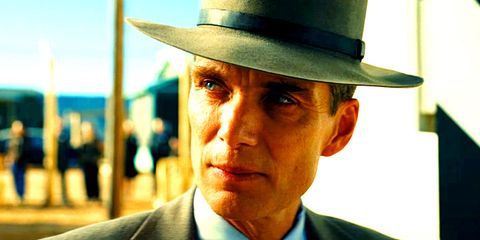Should Oppenheimer Have Shown Hiroshima & Nagasaki? Controversial Debate Explained & Why It Didn't
Controversially, director Christopher Nolan's Oppenheimer does not depict the bombings of Hiroshima and Nagasaki. Could the movie have shown them?

Warning: Contains SPOILERS for Oppenheimer.
Summary
- ▪ Christopher Nolan's biopic Oppenheimer has sparked debate by not directly depicting the bombings of Hiroshima and Nagasaki.
- ▪ The decision to exclude the bombings divided critics, with some arguing that the Japanese victims should have been given a voice.
- ▪ Nolan's reasoning for not showing the bombings was to stay true to Oppenheimer's limited perspective and to avoid exploitative and sensationalized portrayals.
The bombings of Hiroshima and Nagasaki aren't depicted in director Christopher Nolan’s biopic Oppenheimer, sparking debate over whether the movie should have handled this historic event with more care. In 1945, the bombing of Hiroshima and Nagasaki killed between 150,000 and 200,000 civilians. Two Japanese cities, Hiroshima and Nagasaki were bombed by the United States military. In the decades since these bombings, debate has raged over whether the events constitute a war crime or a crime against humanity. J. Robert Oppenheimer, the focus of Christopher Nolan’s Oppenheimer, was central to the development of the atomic bombs used in the bombings of both cities.
While Oppenheimer has been critically acclaimed, some reviewers have taken exception to the movie’s failure to directly depict the bombings of Hiroshima and Nagasaki. Since Oppenheimer himself was instrumental in the creation of the weapon and later became known as the father of the atomic bomb, it stands to reason that some viewers were surprised to see no depictions of the devastation that Oppenheimer’s invention wrought. That said, Nolan noted that his biopic was intended to illustrate the internal life of Oppenheimer alone. As Oppenheimer was unable to conceive of the barbaric enormity of murdering an entire civilian population in an instant, the bombings couldn’t appear onscreen.
Oppenheimer Not Showing Hiroshima & Nagasaki Has Stirred A Lot Of Debate

Since Oppenheimer was released, the debate over the decision to exclude the bombings of Hiroshima and Nagasaki has split critics online. Some commentators argued that the Japanese victims of Oppenheimer’s invention should have been given a voice in the movie’s story. Others argued that depicting Japanese characters only via the bombings of Hiroshima and Nagasaki would have amounted to a tasteless exploitation of their horrific fate. Oppenheimer’s adaptation of American Prometheus touches on both the professional and personal life of the physicist and depicts the decision-makers within the US military who approved the bombing. However, some felt this depiction of the event felt incomplete.
The bombings of Hiroshima and Nagasaki have been depicted onscreen over the decades, although few works recreated the events. Renzo Kinoshita's 1978 short film Picadon depicts the effect of the bomb on the city’s civilian population, while Hideo Sekigawa’s 1953 film Hiroshima showed the day of the bombing from the perspective of local citizens. With a large budget and an experienced director, Oppenheimer was a rare opportunity for a blockbuster to devote screen time to this infamous crime. Nolan’s work on Dunkirk proved he can effectively depict the brutality of war, but this doesn’t necessarily mean the director could bring the unique inhumanity of a nuclear blast to life.
Why Oppenheimer Doesn't Show What Happened In Hiroshima & Nagasaki

Nolan briefly explained to Indiewire that he chose not to depict the bombings of Hiroshima and Nagasaki as this would take the movie outside of Oppenheimer’s perspective. Per Nolan, "We know so much more than he did at the time. He learned about the bombings… on the radio, the same as the rest of the world." Since the biopic centers itself on its subject, Oppenheimer only morally objects to what happened after the fact. The scientist's initial detachment from the hideous potential of the atomic bomb is part of the movie’s point, as viewers are forced to contend with the idea that Oppenheimer didn't imagine its impact on civilians.
Part of Nolan’s reasoning for Oppenheimer’s CGI-free story was that the director wanted the scientist’s life story to feel tangible and grounded. As such, there was an inherent risk of the movie depicting countless innocent Japanese civilians being gruesomely killed without first exploring their lives, their dreams, and the individual human existences that were cut short in a matter of seconds by Oppenheimer’s invention. The depth that a cinematic exploration of the bombings of Hiroshima and Nagasaki deserves would require both the length and sustained focus of 1985’s Shoah, not a few scenes within the larger life story of an individual partially responsible for their mass murder.
Oppenheimer's Criticisms Are Understandable - But Were They Also Unavoidable?

It's easy to see why the criticisms of Oppenheimer exist. After all, Nolan’s biopic is about the man who created an invention that left an indelible mark on Japan’s history and an equally indelible stain on the international legacy of the United States. Despite this, Japanese characters have no agency in the narrative. However, if Nolan's atomic bomb depictions extended to Hiroshima and Nagasaki, Oppenheimer would have rightly been criticized for not exploring the event enough. As such, the question to ask is whether Nolan could win either way. If Oppenheimer didn’t depict the bombings of Hiroshima and Nagasaki, the movie could be accused of whitewashing history.
However, if Oppenheimer had depicted the bombings, the movie would have been accused of cheaply reducing one of the greatest atrocities in human history to a blockbuster set-piece. Depicting the bombings risked looking cheap and exploitative given how difficult it is to simultaneously do justice to the life stories of 200,000 people. Making a movie about the inventor of the atomic bomb, a weapon used to decimate a civilian population, always carried this risk. Oppenheimer’s depiction of the bombings of Hiroshima and Nagasaki could only have succeeded if the movie devoted as much focus and screen time to the bomb’s victims as its creator.
Oppenheimer Couldn’t Do Hiroshima and Nagasaki Justice

By being a relatively mainstream, accessible Hollywood biopic, Oppenheimer could not handle the bombings of Hiroshima and Nagasaki tactfully. Authentically recreating Oppenheimer’s viewpoint, which Nolan opted to do, involved telling a story of a handful of phenomenally powerful American men facilitating the execution of 200,000 Japanese civilians without ever encountering a Japanese person during this process. Oppenheimer including another atomic bomb sequence involving the death of hundreds of thousands of civilians could not have felt like more than a tasteless spectacle unless the biopic focused on the bomb’s victims, at which point it would cease to be a biopic of Oppenheimer.
Artists have successfully wrestled with the impact of the atom bomb’s invention over the decades. Picadon’s deeply unsettling deception of the bombings of Hiroshima and Nagasaki has been endlessly influential in the decades since the short film was released, while director David Lynch’s Twin Peaks episode "The Return, Part 8" offered a chilling, immersive vision of the psychic horror unleashed by the bomb in 2017. However, despite its non-linear flourishes and handful of psychedelic sequences, Nolan’s retelling of Oppenheimer’s life is effectively a straightforward biopic that remains in his head for its runtime. As such, Oppenheimer couldn’t reckon with the enormity of the bombings of Hiroshima and Nagasaki without fundamentally altering its premise.
Oppenheimer Brings Josh Hartnett's Career Full Circle 22 Years Later
With Christopher Nolan's Oppenheimer, Josh Hartnett's acting career has come full circle, given how he had worked on a similar movie 22 years ago.

Warning: This post contains spoilers for Oppenheimer.
Summary
- ▪ Josh Hartnett's portrayal of Ernest Lawrence in Oppenheimer showcases his versatility and range as an actor, allowing him to authentically depict the character's moral conflicts and dilemmas.
- ▪ Compared to his role in Pearl Harbor, where his character's arc primarily focused on romantic and nationalist conventions, Hartnett's performance in Oppenheimer benefits from the moral complexities and real-life undertones of Lawrence's characterization.
- ▪ Hartnett's experience and growth as an actor over the years make him better equipped to delve into a broader range of emotions and deliver a compelling performance in Oppenheimer, marking a significant improvement from his previous World War II film.
Christopher Nolan's Oppenheimer brings a full circle to Josh Hartnett's acting career after 22 years - here's how. In Oppenheimer, Josh Hartnett plays nuclear physicist Ernest Lawrence, who is not only J. Robert Oppenheimer's associate at the Manhattan Project but also a close friend. As seen in Oppenheimer, Lawrence was the head of the Radiation Lab during the atomic bomb's development in the Manhattan Project and, unlike Oppenheimer, he was a strong proponent of the hydrogen bomb.
However, despite their difference in opinions, Lawrence does not testify at Oppenheimer's security hearing toward the movie's ending by claiming that he has fallen ill. Ernest Lawrence's ending scene and his previous contributions to the Manhattan Project make him one of the memorable supporting characters in Oppenheimer and Josh Hartnett perfectly captures all the conflicts and moral dilemmas the character faces towards the end. However, long before Hartnett portrayed Ernest Lawrence in Oppenheimer, he had appeared in another renowned World War II movie.
RELATED: What Happened To Ernest Lawrence After Oppenheimer
Oppenheimer Returns Josh Hartnett To World War II After Pearl Harbor

22 years before Josh Hartnett played Ernest Lawrence in Christopher Nolan's Oppenheimer, he appeared as Captain Danny Walker in Michael Bay's Pearl Harbor. Like Oppenheimer, Pearl Harbor is also based on a true World War II event, but the movie fictionalizes Danny Walker's characterization and his romantic developments with Evelyn Johnson. As Oppenheimer establishes, Josh Hartnett's Ernest Lawrence was a key figure in the atomic bomb's development during the Manhattan Project. Pearl Harbor's Danny Walker, in contrast, was a fictional character placed in the backdrop of the real Pearl Harbor tragedy. Nonetheless, since both movies revolve around World War II, Oppenheimer marks Josh Harnett's return to the sub-genre after more than two decades.
Josh Hartnett's Oppenheimer Performance Is So Much Better Than Pearl Harbor

While an actor's commitment to a given role is one of the primary factors contributing to their performance in a movie, their character's development and depth within the script often determine what they can bring to the big screen. Owing to this, although Josh Hartnett's character in Michael Bay's Pearl Harbor had emotionally stirring moments, Danny Walker's arc primarily revolved around the romantic and nationalist conventions of a heroic World War II character. This seemingly limited his ability to deliver a compelling performance in Pearl Harbor.
In Oppenheimer, Josh Hartnett's screen time may have been limited compared to Danny Walker's in Pearl Harbor. However, the moral complexities and real-life undertones in Ernest Lawrence's characterization allow Josh Hartnett to imbue his performance with authenticity. They also help him showcase his true versatility and range as an actor, allowing him to portray multiple layers of conflicts Lawrence faces when he finds himself at odds with his close friend. Not to mention, since experience is the best teacher, Josh Harnett is a more seasoned actor in Oppenheimer and better equipped with the tools to into a broader range of emotions and convincingly play Ernest Lawrence.









